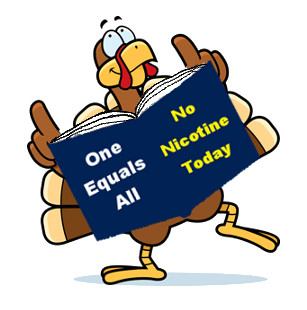"Law of Addiction: administration of a drug to an addict will cause re-establishment of chemical dependence upon the addictive substance."
Yes, once all nicotine use ends, a single subsequent use is extremely accurate in predicting full and complete relapse.

The 1990 Brandon lapse/relapse study followed 129 smokers for two years after they successfully completed a two-week stop smoking program.[1] Lapse was defined as any tobacco use regardless of how much.
Among those who lapsed, the mean number of days between the end of the smoking cessation program and lapse was two months (58 days), with nearly all who lapsed doing so within the first three months.
While 14% took only one or two puffs, 42% smoked the entire cigarette, while the average smoked about two-thirds of a cigarette. A second cigarette was smoked by 93.5% who had lapsed. Nearly half (47%) smoked that second cigarette within 24 hours, with one in five (21%) smoking it within an hour.
The Brandon study found that 60% who lapsed "asked for" the cigarette (bummed it), 23% purchased it, 9% found it, 6% stole it, and 2% were offered it. Also of note, 47% who lapsed drank alcohol before doing so.
Overall, the study found that 88% who "tasted" a cigarette relapsed. In discussing the finding Brandon wrote:
"The high rate of return to regular smoking (88%) once a cigarette is tasted suggests that the distinction between an initial lapse and full relapse may be unnecessary."
The Brandon study's finding was echoed by the 1990 Boreland study which followed callers to an Australian telephone stop smoking line. There, among 339 participants who lapsed (123 who didn't make it an entire day and 172 who stopped for at least 24 hours) 295 or 87% experienced relapse within 90 days.[2]
A third relapse study, the 1992 Garvey study, followed 235 adult smokers for one full year after attempting to quit. It found that "Those who smoked any cigarettes at all in the post-cessation period (i.e. lapsed) had a 95% probability of resuming their regular pattern of smoking subsequently."[3]
Although the challenges of recovery have ended for hundreds of millions of now comfortable ex-users, each lives with nicotine dependency's imprint permanently burned into their brain.
Even after 10, 20, or 30 years of freedom we remain wired for relapse.
We're not stronger than nicotine but then we don't need to be as it's only a chemical. Like the salt or pepper in our shakers, it has an I.Q. of zero. Like the sugar in our sugar bowl, it cannot plot, plan, think, or conspire. And it is not some big or little monster that dwells inside us.
Our blood serum becomes nicotine-free and withdrawal peaks in intensity within three days of ending all use. But just one powerful jolt of nicotine and the deck gets stacked against us. The odds of us having the stamina to withstand and endure nicotine's influence upon the brain without relapsing are horrible.
Brandon, Boreland, and Garvey teach us that while relapse isn't 100% guaranteed, that the odds are so high, that to not treat lapse as relapse is a recipe for defeat, disease, and an increased risk of death.
Also, keep in mind that nicotine dependency studies report that at least 10% of smokers are "chippers." The chipper's genetics somehow allows them to use or not, without getting hooked. How many of the few who survived lapse in Brandon, Boreland, and Garvey were chippers?[4]
Our greatest weapon has always been our infinitely superior intelligence. As taught by Garvey, the most important recovery lesson our intelligence can master is that being 99% successful at not using nicotine produces up to 95% odds of defeat.

My mentor Joel Spitzer's recovery lessons have been deeply burned into my brain. Paramount among them is that there's a single controlling principle determining the outcome for all. It's that total adherence to a personal commitment to not violate the law provides a 100% guarantee of success.
Although obedience may not always be easy, the law is clear, concise, and simple: no nicotine today, not a puff, vape, dip, or chew.
References:
2. Borland R., Slip-ups and relapse in attempts to quit smoking, Addictive Behaviors, 1990, Volume 15(3), Pages 235-45.
3. Garvey AJ et al, Predictors of smoking relapse among self-quitters: a report from the Normative Aging Study, Addictive Behaviors, 1992, Volume 17(4), Pages 367-377.
4. Hughes JR, Gust SW, Pechacek TF. Prevalence of tobacco dependence and withdrawal. Am J Psychiatry. 1987, Volume 144(2), Pages 205-208. doi:10.1176/ajp.144.2.205
All rights reserved
Published in the USA
